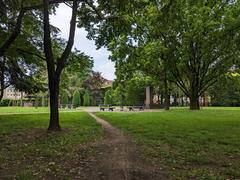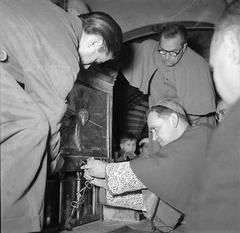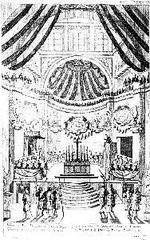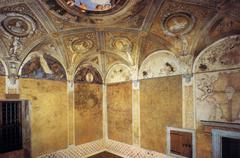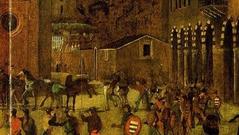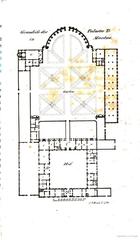
Palazzo Bonacolsi: Visiting Hours, Tickets, and Complete Guide to Mantua’s Medieval Landmark
Date: 04/07/2025
Introduction: Discovering Palazzo Bonacolsi
Located in the heart of Mantua’s UNESCO-listed historic center, Palazzo Bonacolsi—also known as Palazzo Castiglioni—is a striking example of medieval architecture and a tangible link to the city’s tumultuous past. Built at the end of the 13th century by Pinamonte Bonacolsi, the palace stands as a testament to the rise and fall of the Bonacolsi family, their subsequent overthrow by the Gonzagas, and the city’s transformation into a Renaissance stronghold. While the palace’s interiors are largely private today, its formidable brick façade, distinctive battlements, and the adjacent Torre della Gabbia remain must-see sights for visitors seeking to immerse themselves in Mantua’s rich heritage (Italyscapes; Italy This Way; Italia Italy).
This comprehensive guide covers everything you need: the palace’s history, its architectural and cultural significance, practical visiting information, and travel tips to make your exploration of Mantua truly memorable.
Historical Overview
Origins and the Bonacolsi Dynasty
Palazzo Bonacolsi’s construction began between 1272 and 1291, commissioned by Pinamonte Bonacolsi, who became Mantua’s “Captain of the People” in 1273. The palace, built on land purchased from Rolandino de Pacis, quickly became the seat of the Bonacolsi’s hereditary rule. Its robust brick structure, Ghibelline battlements, and fortified tower symbolized both prestige and defensive strength—essential in the politically charged atmosphere of medieval Lombardy (Wikipedia; Italia Italy).
The Bonacolsi family governed Mantua until 1328, a period marked by urban growth and relative stability. They left their imprint on the city with major constructions such as Palazzo Bonacolsi, the Palace of the Captain, and the Magna Domus (Incoming Mantova).
Transition to Gonzaga Power
The Bonacolsi’s rule ended abruptly in 1328 when Rinaldo Bonacolsi was overthrown by the Gonzaga family in a coup supported by rival factions. The palace was seized and became part of the expanding Gonzaga court, eventually integrating into the broader Ducal Palace complex (Wiki Gateway). In the 15th century, the palace housed Countess Antonia del Balzo, reflecting its continued use by Mantua’s elite (Travel Connect Experience).
The Castiglioni Era and Modern Use
In the early 18th century, the prestigious Castiglioni family acquired the palace. Today, it is often referred to as Palazzo Castiglioni. The building remains largely private, with select areas functioning as luxury guest suites and a tavern that allow guests a rare glimpse into its historic interiors (Italyscapes).
Architectural Highlights
Exterior Features
- Façade: The palace’s exposed red brick façade is austere yet elegant, featuring a series of Gothic trifore windows (triple-arched), a hallmark of 13th-century Lombard design (Touring Club Italiano).
- Battlements: The roofline is crowned with Ghibelline battlements, both a defensive feature and a status symbol.
- Entrances: Two main portals mark the building—one with an original ogival (pointed) Gothic arch, the other a Renaissance portal with candelabra motifs, reflecting later stylistic evolution (Will to Fly).
- Torre della Gabbia: Built in 1280, this iconic tower was used as an open-air prison during the Gonzaga era. Its cage for public display of prisoners is a chilling reminder of medieval justice (Travel Connect Experience).
Interior Elements
While access is limited, surviving records and occasional tours reveal interiors with:
- Large halls and private chambers featuring traces of original frescoes and heraldic motifs (Triplyzer).
- Archive holdings such as the autograph manuscript of “Il Cortegiano” by Baldassarre Castiglione (Touring Club Italiano).
- Courtyards adorned with citrus trees and an ancient well, evoking the elegance of Italian palace gardens (Will to Fly).
Stylistic Influences
Palazzo Bonacolsi blends Gothic-Medieval elements with later Renaissance additions. The combination of robust brickwork, pointed arches, and decorative battlements exemplifies northern Italian architecture of the era, while the Renaissance portal hints at the city’s evolving tastes under the Gonzaga’s patronage (Will to Fly; Touring Club Italiano).
Visiting Palazzo Bonacolsi: Practical Information
Location
- Address: Piazza Sordello, 13, 46100 Mantua, Italy
- GPS: 45°09’35.78” N, 10°47’47.18” E (Italia Italy)
Opening Hours & Tickets
- Exterior Viewing: The palace exterior and Piazza Sordello can be visited at any time year-round.
- Interior Access: Regular interior tours are not available due to private ownership. Occasional access may be granted via special events, guided tours, or by booking a stay at Palazzo Castiglioni Luxury Suites or the Bonacolsi Collection (Bonacolsi Collection).
- Tickets: No ticket required for exterior viewing. For special tours or accommodation access, contact providers directly for current pricing and availability.
Accessibility
- Piazza Sordello and the exterior are accessible to most visitors, though cobblestone streets may pose challenges for some.
- Interiors: Accessibility is limited; the main floor is accessible by a step, with the tower reachable only by stairs (Viaggiare Senza Barriere).
Getting There & Parking
- On Foot: Palazzo Bonacolsi is a short walk from Mantua’s train station and major bus stops.
- Parking: Free parking at Viale Mincio, Piazza Virgiliana, Piazza Anconetta, and Campo Canoa (Justin Plus Lauren). Paid options are available closer to the center.
Guided Tours
- Many walking tours of Mantua’s historic center include Palazzo Bonacolsi as a key stop, providing rich historical context and architectural insights (Justin Plus Lauren; Triplyzer).
Piazza Sordello and Surroundings
The palace’s strategic location in Piazza Sordello places it next to Mantua’s most important monuments:
- Palazzo Ducale: Over 500 rooms of Renaissance splendor.
- Cathedral of San Pietro: Romanesque, Gothic, and Baroque styles in one site.
- Torre della Gabbia and Palazzo Acerbi: Remnants of Mantua’s medieval power (Garda Visit).
- Palazzo Te: A celebrated Renaissance villa just beyond the historic center.
Piazza Sordello is also the main stage for city events like the Festivaletteratura, an internationally renowned literary festival (Itimaker).
Preservation and UNESCO Status
Mantua’s historic center, including Palazzo Bonacolsi, was designated a UNESCO World Heritage Site in 2008 for its exceptional Renaissance art and architecture, as well as its well-preserved medieval core (Places of Juma). Conservation efforts continue to stabilize masonry, restore decorative elements, and maintain the building’s historic integrity.
Travel Tips
- Best Time to Visit: Spring and early autumn offer the most pleasant weather. Early mornings or late afternoons provide ideal lighting for photography.
- Dining: Sample local specialties—like risotto alla pilota and pumpkin tortelli—at trattorias near Piazza Sordello (Itimaker).
- Accommodation: For a unique overnight stay, book a room in the Bonacolsi Collection at Palazzo Ca’ degli Uberti (Bonacolsi Collection).
Frequently Asked Questions (FAQ)
Q: What are the visiting hours of Palazzo Bonacolsi?
A: The palace’s exterior is viewable at all times; interior access is limited to special events or guests of the Bonacolsi Collection.
Q: Are tickets required to see the palace?
A: No ticket is needed for exterior viewing. Interior access may require a booking or special event ticket.
Q: Is Palazzo Bonacolsi accessible for visitors with disabilities?
A: The piazza and exterior are mostly accessible, though cobblestone streets may be challenging. The interior has limited accessibility due to stairs.
Q: Can I join a guided tour of the palace?
A: Yes, many city tours include the palace as a key stop, offering historical insights.
Q: Where can I park nearby?
A: Free and paid parking options are available within walking distance. See “Getting There & Parking” above for details.
Quick Reference
- Address: Piazza Sordello, 13, 46100 Mantua, Italy
- GPS: 45.15994, 10.79644
- Contact: [email protected] | (+39) 0376 1410794
- Nearby: Palazzo Ducale, Mantua Cathedral, Palazzo Acerbi, Torre della Gabbia, Palazzo Te
- Recommended Visit Duration: 30–60 minutes for exterior; longer if part of a guided tour
Summary & Call to Action
Palazzo Bonacolsi offers a window into Mantua’s medieval and Renaissance history, standing as a monument to the city’s evolving political and cultural landscape. Whether you’re exploring Mantua’s cobblestone streets, enjoying a panoramic view from Piazza Sordello, or joining a guided tour, the palace is an essential stop for anyone interested in Italian heritage.
For up-to-date information, ticket options, and cultural events, consider using resources like the Audiala app or local tourism offices. Combine your visit with nearby landmarks to fully appreciate Mantua’s UNESCO-listed splendor.
References and Useful Links
- Italyscapes
- Will to Fly
- Italy This Way
- Italia Italy
- Incoming Mantova
- Travel Connect Experience
- Triplyzer
- Viaggiare Senza Barriere
- Garda Visit
- Places of Juma
- Itimaker
- Bonacolsi Collection
- Justin Plus Lauren
Ready to explore Mantua’s historic sites including Palazzo Bonacolsi? Download the free Audiala app for offline maps, expert audio guides, and the latest visitor information. Follow us on social media for updates, travel tips, and event news!




